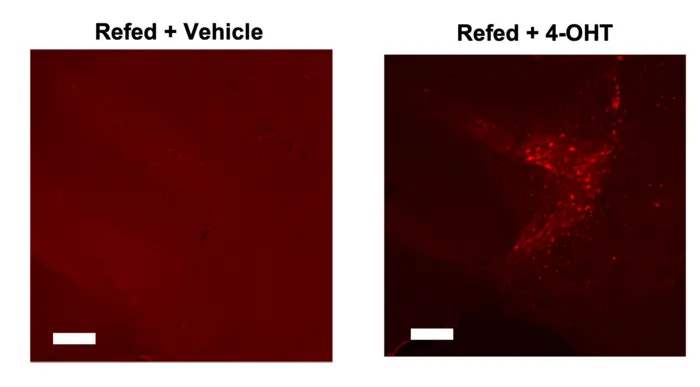Scientists at Scripps Research have identified a group of brain cells that influence when we decide to take our first bite of food. This discovery sheds new light on the complex neural processes behind eating behaviors and could have implications for understanding and treating eating disorders.
The research team focused on a small, understudied region of the brain called the parasubthalamic nucleus (PSTN). They found that certain neurons in this area become highly active during periods of binge-eating. By manipulating these cells, the researchers were able to significantly alter eating and drinking behaviors in mice.
Jeff Dunning, PhD, a staff scientist at Scripps Research and first author of the study, explains: “In our study, we used a technique that let us turn on cells in the mouse brain that were activated by a specific experience—in this case, binge-eating. Once we have captured this ensemble of PSTN cells, we can turn them on like a light switch and watch what happens to the animals’ eating and drinking.”
Surprising Effects on Eating and Drinking Behaviors
When the researchers activated these specific PSTN neurons, they observed striking changes in the mice’s behavior. Normally, hungry mice begin eating quickly when food becomes available. However, with these neurons activated, the mice took much longer to start eating. Unexpectedly, the mice also began drinking water much faster than usual.
“Our results tell us that this specific group of PSTN cells guide the early stages of hunger-driven decision making, before eating actually occurs,” says Dunning. “The effect on water drinking is somewhat counterintuitive, but it might be related to prandial thirst—the phenomenon whereby thirst gets stimulated as soon as we start eating.”
By selectively manipulating smaller groups of cells within the PSTN, the team was able to pinpoint which neurons were responsible for delaying eating and which accelerated drinking. They also discovered another set of PSTN cells that encouraged mice to consume more sweet foods.
Implications for Eating Disorders and Addiction
Candice Contet, PhD, associate professor in the Department of Molecular Medicine at Scripps Research and senior author of the study, notes: “Altogether, these results reveal that PSTN neurons exert a complex combination of functions. Several studies had previously shown that PSTN activity can limit the amount of food eaten, but the fact that certain PSTN neurons control the onset of feeding or drinking, or even promote the consumption of food ‘treats,’ is entirely novel.”
The researchers believe their findings could have significant implications for understanding eating disorders where individuals struggle with either too much or too little control over when they start eating. This mechanism might also play a role in the loss of control over consumption of addictive substances, an area the team is currently investigating.
This groundbreaking research, published in Molecular Psychiatry on July 4, 2024, was supported by funding from the National Institutes of Health. As scientists continue to unravel the intricate workings of the brain’s hunger and appetite control systems, we may be one step closer to developing more effective treatments for eating disorders and addiction.
The study, titled “The parasubthalamic nucleus refeeding ensemble delays feeding initiation and hastens water drinking,” represents a significant advancement in our understanding of the neural circuits that govern eating behaviors. As research in this area progresses, it could lead to new therapeutic approaches for a range of disorders related to appetite and consumption.

